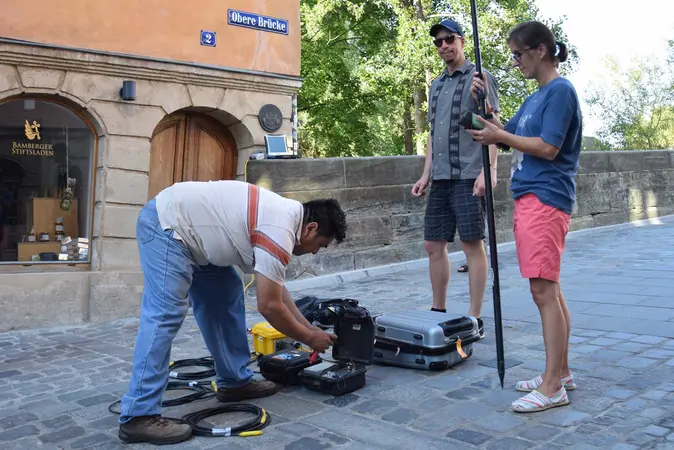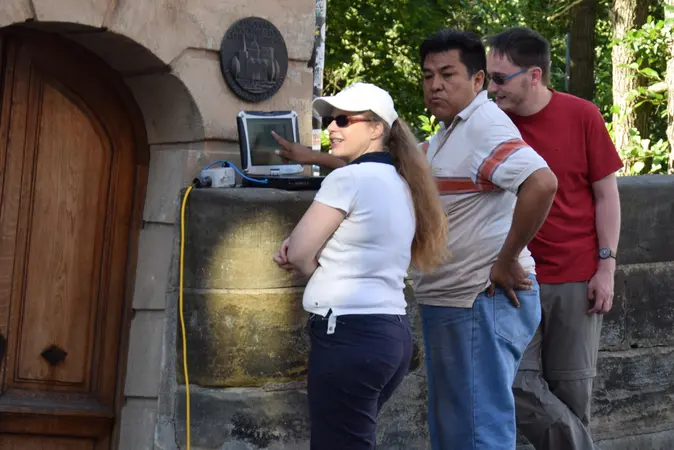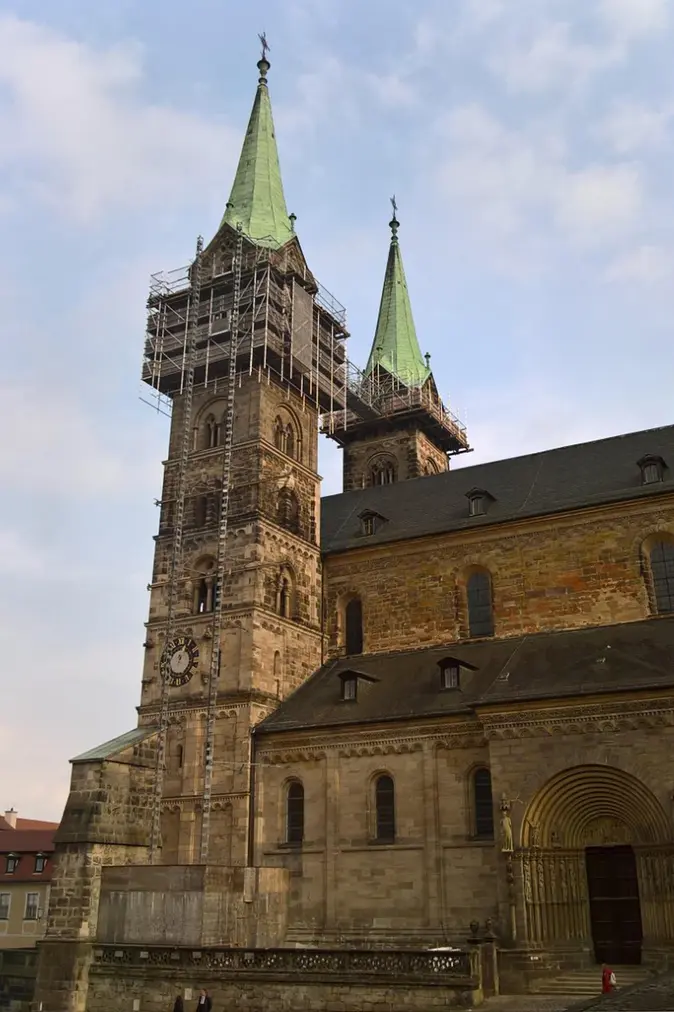Research team is testing seismic instruments on the Upper Bridge in the maneuvering area (from left): Jesús Pacheco Martínez, Till Sonnemann and Katja Kothieringer.
Mona Hess, Jesús Pacheco Martínez and one of their students (from left) discuss the data resulting from the micro-seismic measurement.
In a week’s time, the team will monitor Bamberg’s cathedral with different types of measuring instruments.
Monitoring Bamberg’s Cathedral
Construction engineer Dr. Jesús Pacheco Martínez embarks to dizzy heights with students: he monitors small, micro-seismic vibrations in the towers and on the roof truss of Bamberg’s cathedral. Not only do cars that pass by and the ringing of the bells have an impact on the building, but storms do, too. How much harm do these outside influences have on the cathedral over time? Jesús Pacheco Martínez, from the Mexican university, Autónoma de Aguascalientes, wants to find this out during his 3-week stay in Bamberg as a guest professor at the university. Micro-seismic experts were invited by Professor Dr. Till Sonnemann, who holds the assistant professorship position for Digital Geoarchaeology. A summer school course is being held together with Professor Dr. Mona Hess, who is the department chair for Digital Technologies in Heritage Conservation. This offer enriches the year of 2018, the 25th anniversary of Bamberg’s “oldtown” being declared a UNESCO World Heritage Site.
Monday, July 30th 2018 is the first day of this year’s Summer School, a course at the University of Bamberg, in which 20 students will work together, half of them coming from Bamberg and the other half from other countries. In a week’s time, they will learn the different non-destructive methods for monitoring the cathedral. The course is called “Monitoring Heritage 2018”, which is being offered for the first time by the Institute for Archaeology, Heritage Sciences and Art History (IADK), which will be financially supported by central funds of the university and the Upper Franconian Foundation. “The goal is to bring students from different areas of study and nationalities together and teach them new monitoring techniques in the area of Heritage Conservation. They will make international contacts, have fun and will get to know the University of Bamberg,” says Till Sonnemann.
Heating Systems underneath the Cathedral
Apart from micro-seismic vibrations, under the instruction of Till Sonnemann, they will also examine the inner and outer areas of the cathedral with a geo-radar, which will help capture underground electromagnetic waves. “We want to find out where the heating systems run underneath the building,” says Till Sonnemann. “With that, we are supporting the current building measurements at the cathedral: after analysis, we will know where electrics can be laid.” Plans showing the underground system aren’t available as of yet.
Mona Hess is heading another project that will, with the help of the participants, measure the “Veitspforte”, one of the cathedra’s gates on the north wall, with a 3D-scanner. A capital, the adorned, upper border of a pillar, should be replaced as part of the building measures. “You can’t recognise the adornments anymore due to weathering,” says Mona Hess. “Before the capital is replaced, we document it for posterity.”
Cathedral Construction Archive Obtains Results
In the mornings, the participants carry out measurements at the cathedral and in the afternoons, they assess the data in the computer labs of the Heritage Sciences and Technologies in Heritage Conservation research centre (KDWT). The students will present their results on Friday, August 3rd, 2018 and afterwards they will be obtained by the cathedral construction archive. “Whenever we make interesting discoveries, we can then develop a research project,” says Till Sonnemann. It is also possible to work together longer with Jesús Pacheco Martínez. Furthermore, he adds that the concept for a Heritage Sciences-archaeological summer school can be used again in the future.
This News was translated by Cassandra Laren Perez.


